
All categories
Featured selections
Trade Assurance
Buyer Central
Help Center
Get the app
Become a supplier

(1743 products available)














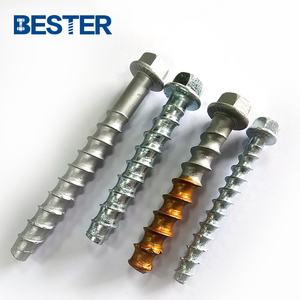


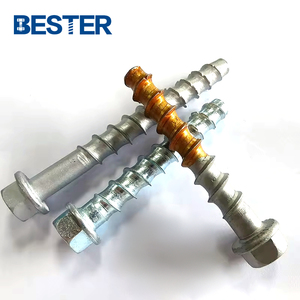
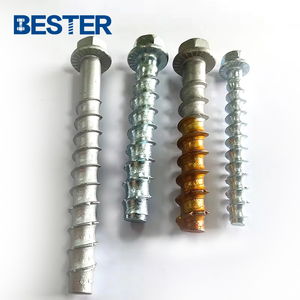






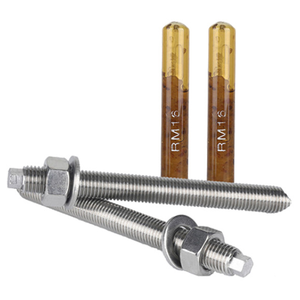



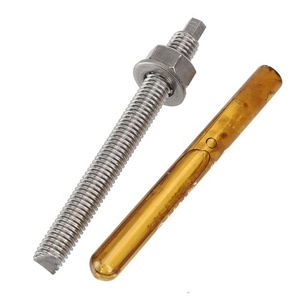



Like many anchor bolts, epoxy anchor bolts come in various types determined by the installation environment and what they will be exposed to, i.e., temperature, humidity, contaminants, load types, etc. Common types of epoxy anchor bolts include:
This is common due to its tensile strength, durability, and relatively low cost. These bolts take an external coating, e.g., zinc, chrome, or Xylon, to protect them from corrosion. However, they are not suitable for highly corrosive environments, nor can they withstand high temperatures.
This bolt is preferred for its excellent corrosion resistance. 304 or 316 grade stainless steel epoxy anchor bolts are commonly used in highly corrosive environments, like marine. Grade 316 gives added chlorine and salt water resistance. 316 stainless steel epoxy anchor bolts are also slightly larger to better accommodate thermal expansion with the heat.
These are usually carbon steel bolts that have been tempered or heat-treated to offer more tensile strength. Grade 8.8 and 10.9 high-strength epoxy anchor bolts are often used in construction and other heavy industries with more sensitive loads.
These are galvanized carbon steel anchor bolts that have been paired with an epoxy coating. The galvanization process includes the bolt being dipped into molten zinc to protect it from corrosion, while the epoxy resin provides additional protection and helps the bolt embed itself more effectively into concrete. These bolts are ideal for environments prone to frequent moisture and wet concrete.
This has a hex head or top that enables easy wrench fastening or loosening. Hexagonal epoxy anchor bolts come in all the above carbons, stainless, and high-strength steel for various applications.
Other than anchor bolts, there are epoxy tie rods, which are vertical structural members that, together with other members, form a building’s framework, e.g., holding concrete slabs. There are also epoxy anchors for rods, which are long, slender, cylindrical fasteners used to connect parts or to enable one part to have a key locking feature with another. Finally, anchor studs integrated into a structure can support other materials.
There are multiple applications and benefits of using anchor bolts in industry, such as protecting against corrosion, supporting structural loads, and anchoring into concrete. Common applications include:
Epoxy anchor bolts are used in construction projects to secure structural elements, such as steel frames. They provide a reliable anchoring solution for various load-bearing installations, ensuring long-term stability and alignment.
The oil and gas industry has some of the harshest working conditions. Consequently, epoxy anchor bolts are extensively used in drilling platforms, refineries, and pipelines to withstand corrosive chemicals, extreme temperatures, and high-pressure.
Marine environments are prone to moisture and salt exposure, which rapidly deteriorates ordinary bolts. Epoxy anchor bolts are used in boat moorings, dock constructions, seawalls, and offshore structures to ensure reliable and long-lasting anchoring under corrosive conditions.
Manufacturing plants, such as for auto, food and beverage, and chemical, have heavy machine vibrations, extreme temperatures, and chemical exposures. Anchor bolts provide reliable solutions for securely mounting machinery, production equipment, and conveyor systems while withstanding all these conditions.
Wind and solar energy installations rely on epoxy anchor bolts to secure turbines, solar panels, and other equipment. The bolts provide the necessary strength to withstand wind loads and ensure the structures remain stable over time.
Bridges, highways, and other infrastructure also use epoxy anchor bolts to secure reinforcements and other structural components. They help with post-tensioning in concrete structures, providing the necessary tension to enhance the load-carrying capacity.
All the above areas, as well as heavy industry, use anchor bolts to insulate machinery and equipment from potential damage due to the vibration propagation from nearby machines. In addition, the epoxy coating acts as a thermal insulation layer that reduces heat transfer between bolted components and the environment.
A1. Epoxy anchor bolts are not suitable for everyone. For example, the epoxy resin requires the surrounding concrete to be in good condition with no cracks and of the right temperature for it to expand and achieve optimal bonding. There are other anchoring solutions, such as mechanical and expansion anchor bolts, that are much more straightforward and cheaper.
A2. Sure, but it must be the right type. While epoxy anchor bolts like resin often fail in extreme heat environments, high-temperature-resistant epoxy is designed to withstand up to 200oC. Stainless steel anchor bolts are also suitable because they do not expand with temperature as carbon steel does.
A3. Several factors influence the longevity of anchor bolts, such as environmental exposure, load conditions, and installation quality. Stainless steel bolts have excellent corrosion resistance and can last a lifetime in harsh environments. Carbon steel bolts can also last for decades in dry, low-corrosive environments, while galvanized and epoxy-coated anchor bolts can last up to 20 years in moderately corrosive environments.
A4. No maintenance is required for epoxy anchor bolts after installation. They do not need to be regularly tightened or checked. However, it is advisable to closely inspect for signs of corrosion, loosening, or concrete damage in high-stress and corrosive environments and applying necessary repairs or replacements as they arise.